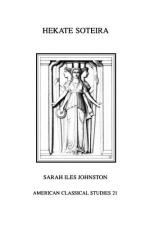|
This section contains 1,123 words (approx. 4 pages at 300 words per page) |

|
HEKATE is best known as the mistress of threatening, restless ghosts because Greek and Roman literature emphasized this sensational aspect of her personality beginning in the fifth century BCE (e.g., Euripides Helen 569–570). This role led to Hekate's association with magic, which often relied on the cooperation of the ghosts whom she controlled (Euripides Medea 397; Horace Satires 1.8.33). Later authors followed suit; for example, Shakespeare's Macbeth makes her the leader of a band of witches. Her association with ghosts and the darker side of magic also led to her portrayal, in later antiquity, as a threatening and horrible creature who might look like a snake, howl like a dog, and make her meals among the graves (Papyri Graecae Magicae IV.2549, 2856–2869).
However, other Greek and Roman sources, some of which go back to before the fifth century BCE, suggest that in antiquity Hekate was usually viewed as a normal, even...
|
This section contains 1,123 words (approx. 4 pages at 300 words per page) |

|


